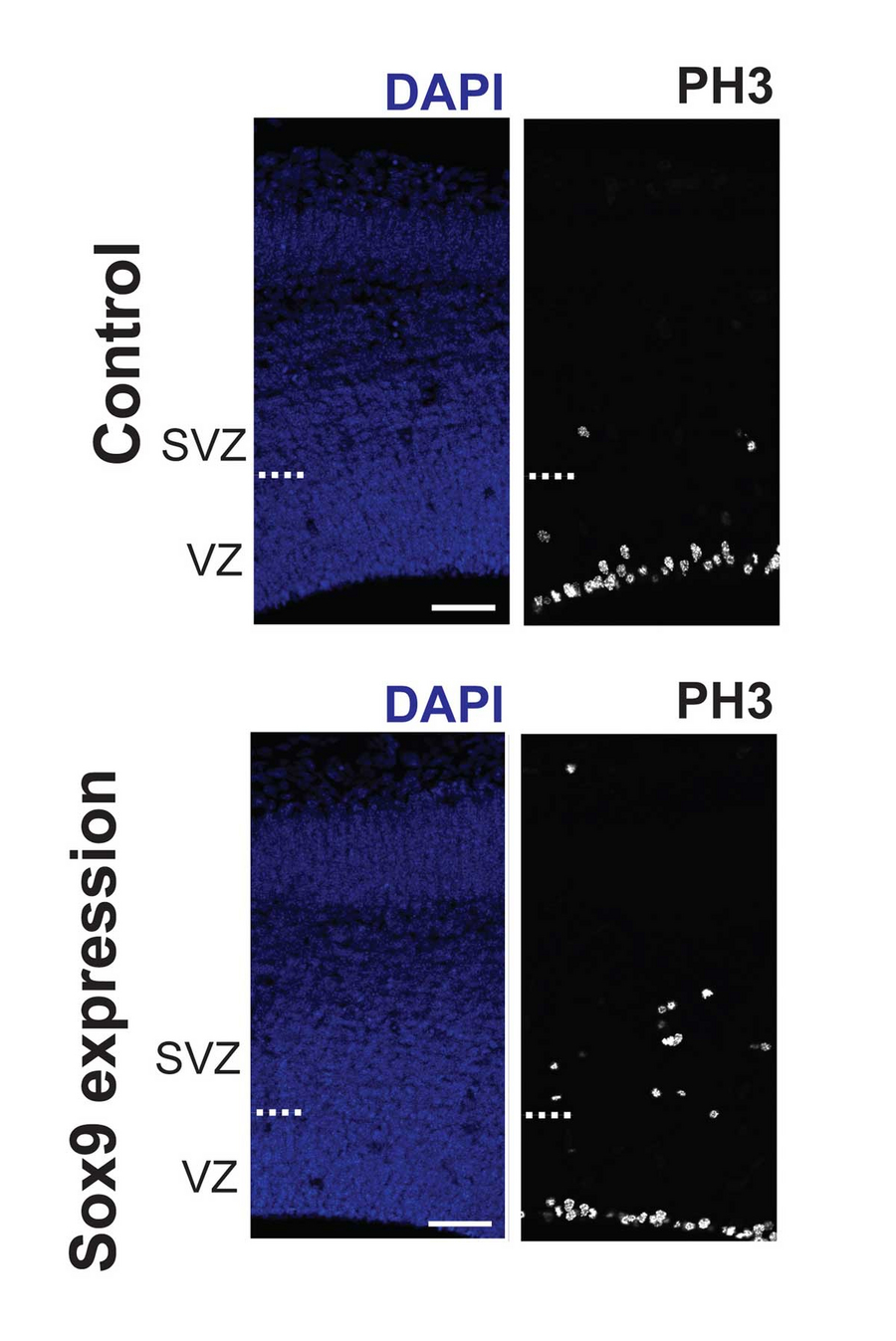
Compared to control (top images), expression of the transcription factor Sox9 in the embryonic mouse neocortex (bottom images) increases the proliferation of basal progenitors, revealed by immunofluorescence for the mitotic marker phosphohistone H3 (PH3, white). Note the increase in PH3-positive mitotic basal progenitors in the subventricular zone (SVZ) of the cortical wall stained with DAPI (blue), a marker of cell nuclei. Copyright: Güven et al. / MPI-CBG
The expansion – during development and evolution – of the neocortex, which is the seat of our higher cognitive abilities, is largely based on the proliferative capacity of neural progenitor cells, notably the so-called basal progenitors. The ability of basal progenitors to proliferate, that is, to produce more basal progenitors, is low in mammals with a small neocortex such as mouse, and high in mammals with an expanded neocortex such as humans. The generation of basal progenitor cells can be increased by components of the extracellular matrix (ECM), a non-cellular three-dimensional macromolecular network that has been previously associated with the expansion of the neocortex. These ECM components stimulate basal progenitor proliferation via the signaling of integrins, which are membrane receptors that facilitate cell-ECM adhesion and allow rapid and flexible responses to events at the cell surface.
Given the stimulation of basal progenitor proliferation by ECM components, the key question is: Which transcriptional machinery governs the expression of ECM components in the germinal zone of the neocortex in which the basal progenitors reside, the so-called subventricular zone (SVZ)? And which factors of this transcriptional machinery can explain the differences in ECM production across the various mammals? The research lab of Wieland Huttner provides answers to these questions in their latest study. The scientists found that the transcription factor Sox9 drives the expression of ECM components. A transcription factor is a protein that helps turning specific genes ‘on’ or ‘off’ by binding to the respective DNA. Ayse Güven, the first author of the study, explains: “Sox9 is expressed in the neocortical SVZ of ferret embryos and human fetuses, which develop a relatively large and folded neocortex, but not in the neocortical SVZ of mouse embryos, which develop a relatively small and unfolded neocortex. When Sox9 is introduced into mice, where it normally is not expressed, it increases basal progenitor proliferation.” One of the components of the ECM whose expression is increased by Sox9 in mice is laminin 211, which in turn increases basal progenitor proliferation in embryonic mouse neocortex.
Wieland Huttner, who supervised the study, summarizes: “Taken together, these findings demonstrate that Sox9 exerts concerted effects on transcription, basal progenitor proliferation, and consequently neuron production, suggesting that Sox9 may have contributed to promote neocortical expansion. Our study will likely be beneficial for understanding neurodevelopmental disorders and could eventually contribute to novel therapeutic approaches.”
Ayse Güven, Nereo Kalebic, Katherine R Long, Marta Florio, Samir Vaid, Holger Brandl, Denise Stenzel, Wieland B Huttner: Extracellular matrix-inducing Sox9 promotes both basal progenitor proliferation and gliogenesis in developing neocortex. eLife, 19. March 2020 Doi: 10.7554/eLife.49808